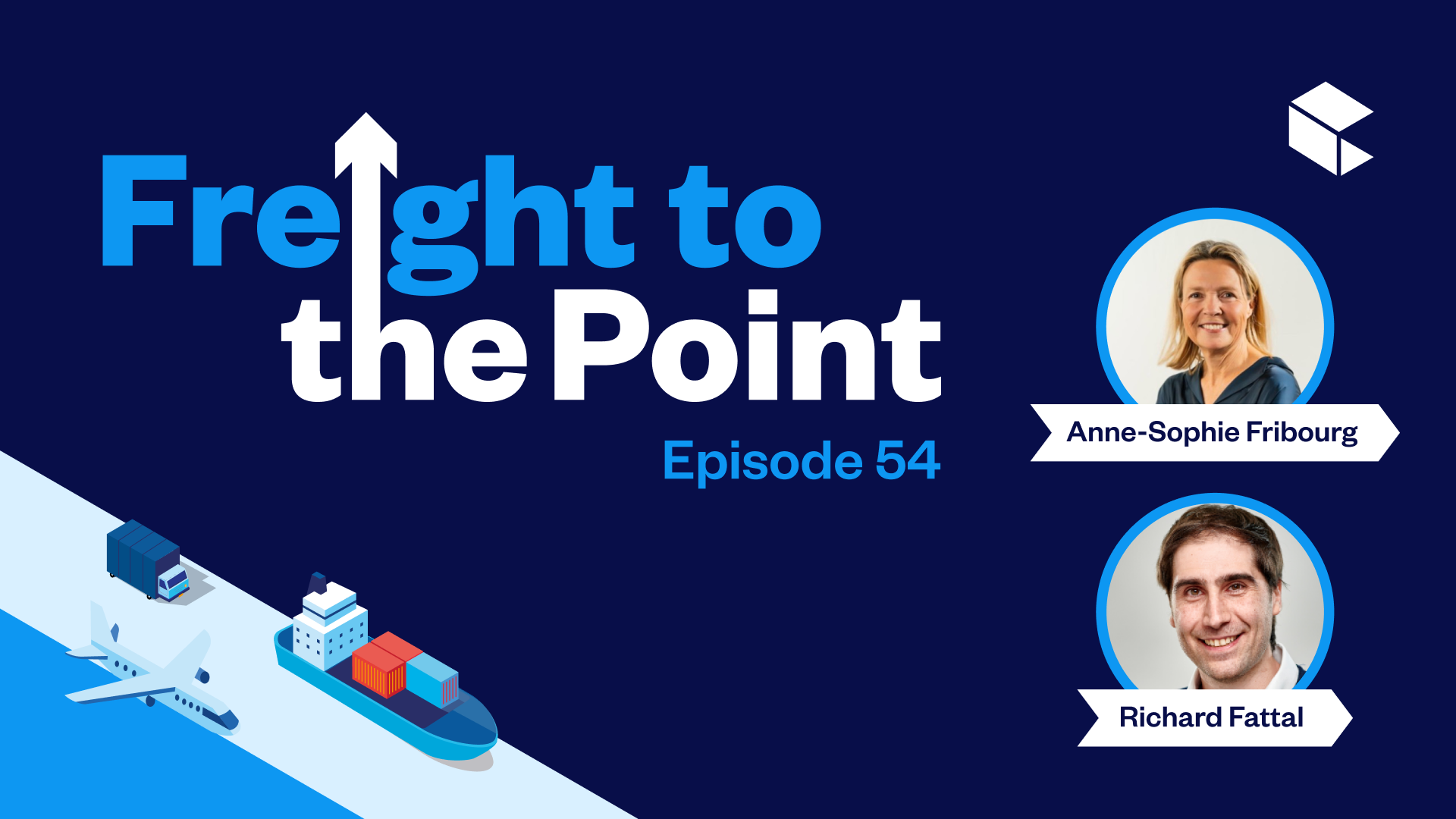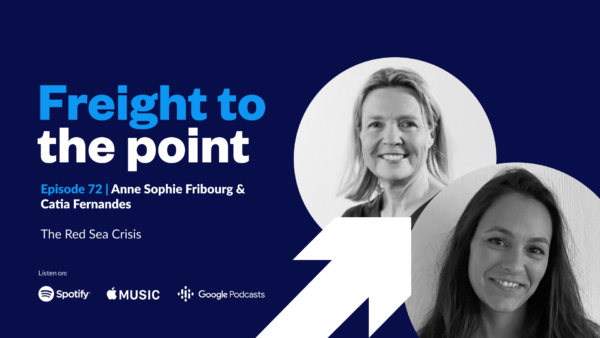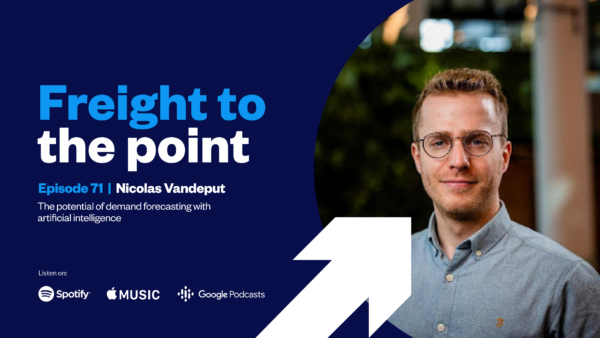Episode 54:
Zencargo's May Ocean Update
See all episodes

Want to find out about our prediction for rate trends over the next couple of months?
Then don’t miss out on the latest episode of Freight to the Point as Anne-Sophie Fribourg, VP of Ocean at Zencargo and Richard Fattal, Chief Commercial Officer and Co-Founder at Zencargo delve into the most recent updates on the ocean market.
They talk about:
- The development of the carrier industry over the past couple of months
- The rate increases on the Trans Pacific trade earlier this month
- Predictions for rate trends in June and July
Anne-Sophie Fribourg
Anne-Sophie has over 20 years of experience in the freight forwarding industry, having worked in Singapore, the Middle East region and France for a French freight forwarder. At Zencargo, Anne-Sophie leads the ocean team to obtain the best rates and space and build supply chain resilience for our customers.
Richard Fattal
Richard Fattal is Co-Founder and Chief Commercial Officer of Zencargo, the digital freight forwarder enabling organisations to make smarter decisions through real-time data of their supply chain. Based in London, Zencargo helps customers manage their supply chain such as Swoon Furniture and Ribble Cycles.
Resources
Hi, and welcome to another episode of Freight to the Point. I’m Anne-Sophie Fribourg. I’m in charge of ocean freight activities in Zencargo. Today we have invited Richard Fattal back on again to talk about what’s happened in the ocean market recently and what shippers should be keeping their eyes on. Richard works very closely to customers and he’s offering ocean solutions to our customers and also provide the rate consultation. So welcome Richard.
Richard Fattal:
Thank you very much for having me on Anne-Sophie.
Anne-Sophie Fribourg:
So just to recap our last ocean update, we have discussed the market stabilisation. We have discussed about what has happened with the news of the two separation coming into effect in 2025, and also some industrial action occurring across Europe. Today, Richard, I’d like to know what has developed in the industry in the last months.
Richard Fattal:
Thank you. One of the topics we’ve covered before on the show was the reaction and the pace of the reaction of carriers to the slackening of demand in the market. So since the beginning of the year, there have obviously, as you will have seen, been substantial blank sailing programs in the market. And what I’ve said before on the show is that the pace of those blank sailing programs was not as rapid as during the COVID period when there was an initial fear of reduction of demand in the market and the carriers reacted really quickly. What we managed to see by sort of February, March, was that the pace of blank sailing programs actually did catch up with the market, with the demand, and the market stabilised.
So through until the end of March, we saw rates coming all the way down and then a stabilisation of rates across all trades really, Asia Europe, to some extent the Mediterranean market, and the Trans-Pacific, with really the only holdup market being the Transatlantic market. What we started to see in April was a little bit of a sign of life in the market, a little bit of a rebound. And the big question that was on everyone’s mind was what was going on? Was this really a reflection of more demand? The Wall Street Journal said the rapid decline in pricing may have bottomed out. Many publications were broadly saying, okay, we’ve got stabilisation. And then we suddenly saw a little bit of a bump, we saw a bump certainly tailing off of the reductions on Asia Europe.
Anne-Sophie Fribourg:
We saw there was an increase on the TP beginning of May and carriers started to announce it middle of April, whereas there was no surge in volumes. How do you explain it? How do you think it’s going to be sustainable in the coming weeks? Can you tell us a bit about that?
Richard Fattal:
Yeah, so as we’ve discussed, we kind of had this bottoming out of the market and, let’s say, a reduction in the rate of declines for a little bit. And then suddenly rates were stable. I think there were some orders that were coming through for May and the carriers maybe got a little bit ahead of themselves. And the other thing to note is that May is a very important time of the year for the steamship lines, the ocean carriers, because they’re negotiating the long-term TP contracts. And this year in particular, the largest beneficial cargo owners were late in their negotiations and they were to some extent holding out on the negotiation to wait and see where the market would be. And I think what the carriers had in their toolkit was to say, okay, well, look, the rates aren’t going down. Maybe the market can sustain an increase in the rates and maybe that will give us a better negotiating position for the long-term market.
So what they did was they introduced a general rate increase in the market of up to $600 depending on the carrier. But what we did see was almost straight away there were rapid negotiations between market players who were on the spot market and the carriers and we saw a slow and steady erosion of that GRI. In rare cases it was almost entirely removed, but I would say on average around two to $300 of the $600 increase stuck in the market. But it really wasn’t the big general rate increase that was maybe hoped when it was introduced.
Anne-Sophie Fribourg:
The carriers have planned to implement another GRI beginning of June. Now that nearly all BCO have signed their long-term contracts, do you think they will be able to implement this GRI?
Richard Fattal:
Look, I think it’s going to be difficult. For the moment, we don’t see a pickup in demand. The general seasonal pickup normally happens into July and then for the next, let’s say, couple of months from there. Early June, generally less so. But for now, the visibility that we have on the market is that the demand just isn’t there. So I would say that I think that we will see more volatility on rates this year in terms of carriers trying to opportunistically implement increases where they see a return of volume and where the blank sailing programs are holding and there’s a little bit of a surplus of cargo at the ports, wherever possible they’ll try to introduce a GRI. But I think the overall environment and the overall capacity in the market means it’s going to be quite difficult until there is a sustained return of demand in the market. And we don’t see that really happening at least until later in the summer from the position that we’re sitting in ow.
Anne-Sophie Fribourg:
You have the same analysis on Asia Europe. Asia Europe is a bit different. There is no long-term contracts being signed at that moment, but we’ve seen, as you say, the surge in volume in April. And some carriers have tried to implement kind of increase on the rates and some not. So we are a bit back to a, I would say, a flat market. What do you foresee for June and July on that particular trade?
Richard Fattal:
I think it’s pretty much the same, I think unless we see a generalised increase in demand. I would say from our conversations with customers, there have been very few customer conversations I’ve had where they’re really talking about a turnaround in the market or a turnaround in the buyer base. We continue to see high levels of inflation. The Bank of England, for example, just increased interest rates. There was some positive news in terms of the reduction in some of the pricing they’re seeing in the market, but they felt it necessary to continue to increase rates. And so inflation seems to be sticking around for a little bit longer than people had anticipated. And as a result, interest rates are staying higher for longer. And we see this having a cooling effect on the market and we’re really seeing this reflected in our customer’s confidence, customers and beneficial cargo owners’ confidence to restock and their ability to work through some of the stocks that they already have. So broadly, the forecasts that we’re hearing are ones where people don’t really anticipate substantial restocking until quite a bit later in the year.
Anne-Sophie Fribourg:
Okay. And when we talk about sourcing, we hear a lot of talks in the industry saying that there are big manufacturing shifts from China to other hubs, can be Southeast Asia. We hear a lot about Southeast Asia, about India, about Nearshoring. What is your insight and have you seen any of our customers moving towards these current shifts?
Richard Fattal:
India and Thailand are markets where we’re seeing some moves more recently. Vietnam is probably the most substantial winner of the pandemic from what we’ve seen, particularly in the space of apparel. We’ve seen some very significant resourcing shifts from China to Vietnam where customers have relocated a significant percentage of the production. What I would say is you have to really think about some of the long-term infrastructure investment that is needed for these sourcing decisions. So in some markets, particularly in the semiconductor technology space, the investment in machinery and know-how that you need to be able to supply markets and the scale that you need to be able to supply these markets. EV, solar, which are key growth markets at the moment, are predominantly supplied by China. And we don’t really see any shifts or substantial shifts there. It’s in the less sophisticated industries that we see real shifts out of China towards Vietnam and India.
And then I would say in terms of the transport infrastructure, it’s also a key consideration. The transport infrastructure in China is really quite incredible. And when you look at Vietnam and India, yes, there’s certainly quite a sophisticated rail network in India for the movement of containers, but the port capacity out of China compared to Vietnam and India is also quite notable. One notable point is that in Vietnam, the north of Vietnam, which is a key growth market, doesn’t have the capacity for the largest vessels to anchor. And so we see a lot of movement from North Vietnam to South Vietnam by feeder vessel. And so the carriers are really thinking about the extent to which they can add further capacity kind of in Vietnam and India as markets, but it’s not as simple as just a switch overnight, both in terms of the sourcing and factory infrastructure, but also in terms of the transport infrastructure. And of course, know-how is the key component.
Anne-Sophie Fribourg:
Does it have an impact on the rates, the rates from Southeast Asia are coming closer to the rates out of China?
Richard Fattal:
Yeah, definitely. So we’ve seen carriers basically put more capacity onto the feeder services in general because there’s a shift in this sourcing dynamic. But then at the same time, because of the, let’s say, lack of demand or structural reduction in demand, for the moment at least, we’ve seen a normalisation of the difference between the China ports and what would normally be considered the Southeast Asia outports to the extent that we see less and less of a premium basically added to the ocean freight. And this is really a reflection of the fact that the different carriers are really competing for market share in the Southeast Asian market and they see it as a key growth area.
Anne-Sophie Fribourg:
Okay, thank you very much Richard. My last question would be for our customers, I would like to know what would be, considering the market dynamics, considering the industry shifts that you just described, what would be your advice for our customers in terms of rate negotiation, in terms of strategy? Would it be to contract long-term rates, to go on index-linked contracts, or just to remain on the spot market? Since you explained very well that we are still in a very volatile environment and we don’t know when this is going to end.
Richard Fattal:
Yeah, a hundred percent. And it’s funny, you and I have this conversation often, and I think as always it really depends on the customer’s position. But what I would say more generally is that, you should really think about these low market levels, the relative’s ability of the rate environment as an opportunity to lock in some stability, I would say, in your core product range. Because if you know you’re going to be shipping cargo week in, week out and you’re facing an environment with some instability in the market from the perspective of sailing regularity, having a regular relationship with a carrier or via your freight forwarder on a particular line or vessel or alliance can be very helpful for ensuring space continuity through the year. And it also means that should there be GRIs that the carriers attempt to implement, you can be safe of those GRIs through the year. Even if those GRIs don’t stick long term, you might have some volatility in your pricing from week to week.
On the flip side, if you have some extra volume, some volume that you’re less sure about, and if price is really an important consideration in your market competitiveness, I would say it’s a weaker market environment and it’s one where you can hold some of your cargo back to be on the spot market. So I think a thoughtful strategy that combines taking advantage of the rates that might be lower for longer and ensuring some stability with being maybe a little bit more opportunistic on that extra cargo that you might have is probably the right strategy. We don’t see a very significant peak in the market for now, but it does make sense to have some security because it’s amazing how quickly the market environment can change when it changes and therefore it’s always quite nice to have some stability and to be able to weather that.
Anne-Sophie Fribourg:
Sure. And we’ve seen that for many weeks, many months now. Thank you very much, Richard, for all of these very valuable insights. I would recommend to our customers that they come for a bespoke consultations where we can really analyse in depth what are the needs and how we can propose a real adaptive solution according to the specific trade and market environments. Thank you very much.
Richard Fattal:
Thanks for having me on.

Episode 72: The Red Sea Crisis
In the latest episode of Freight to the Point, we’ve featured our most rec...

Episode 71: The potential of demand forecasting with artificial intelligence
In the most recent instalment of Freight to the Point, Lucie Phillips, Zen...

Episode 70: Rates: What's next for 2024?
As we prepare for the year ahead, it's crucial to consider the three pillars...

